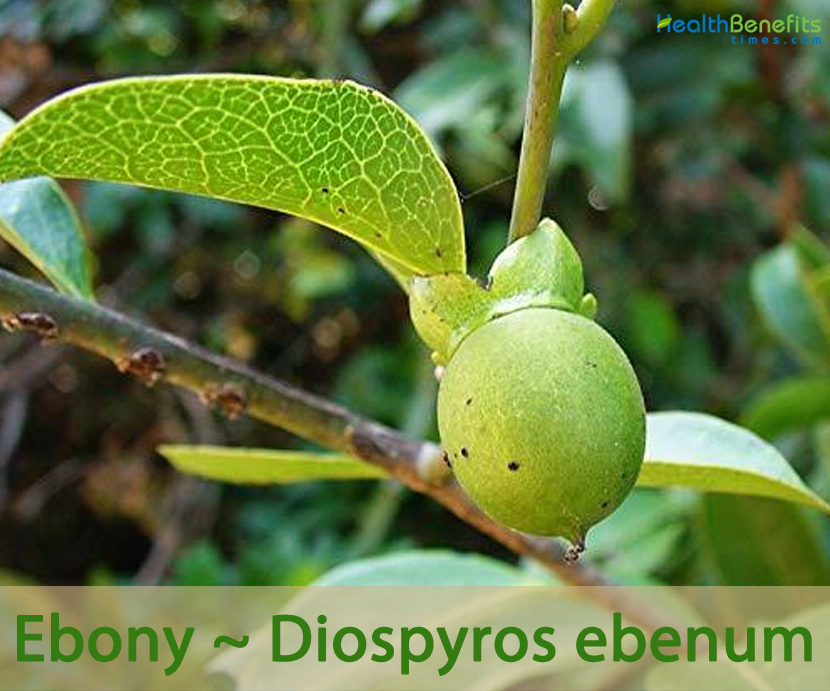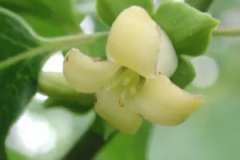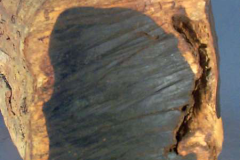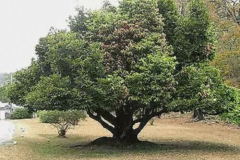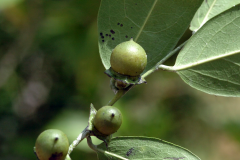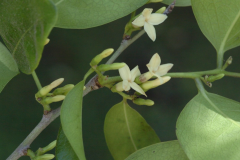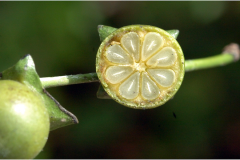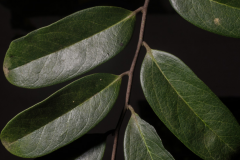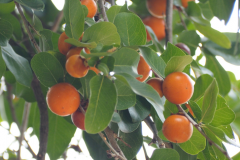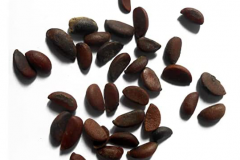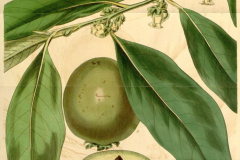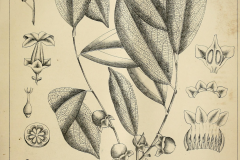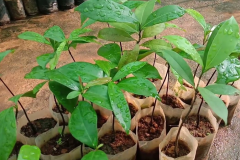| Ebony Quick Facts | |
|---|---|
| Name: | Ebony |
| Scientific Name: | Diospyros ebenum |
| Origin | Southern India, Sri Lanka and Indonesia |
| Colors | Initially green turning to grey as they mature |
| Shapes | Large, smooth, green, rounded, 9 to 12 centimeters in diameter, more or less depressed at its apex, enveloped at its base by a persistent calyx |
| Flesh colors | Yellowish, turning nearly black at maturity |
| Health benefits | Support blistering plaster, fevers, leprosy, ringworm, itching, cough, asthma, diabetes, eye diseases, dysentery, intestinal parasites, leprosy and fever. |
| Name | Ebony |
|---|---|
| Scientific Name | Diospyros ebenum |
| Native | Southern India, Sri Lanka and Indonesia |
| Common Names | Ebony, Ceylon Ebony, Mauritius Ebony, Ebony Persimmon, Black Sapote, Ceylon ebeny tree, East Indian Ebony, Persimmon Ebony, Karingali, Karu, Mushtambi, Vayari, Ebans, Abnus, Ebony tree, Eba na, Tuki, Nallavalludu, Nalluti, Tumiki, Tumbi, Karunkali, Karai, Karemara, Vauari, Kendhu, Kaluwaru, Karungaali |
| Name in Other Languages | Afrikaans: Ebbehout Amharic: Ibonī (ኢቦኒ) Albanian: Zezak Arabic: Khashaba al’abnus (خشب الأبنوس), kharmal ‘abnusi (خرمال أبنوسي) Armenian: Anal (անալ) Azerbaijani: zənci Basque: Ebony Belarusian: Cornaje dreva (чорнае дрэва) Bengali: Ābalusa (আবলুস), Gab Bosnian: Abonos Bulgarian: Abanos (абанос), abanosovo dŭrvo (абаносово дърво) Catalan: Banús Cebuano: Ebano Chichewa: Ebone Chinese: Wu mu (乌木), He shi , Wūmù (zhíwù) (乌木 (植物) Corsican: Ebanu Croatian: Abonos Czech: Eben Danish: Ibenholt, Sort Ibenholt Dutch: Ebbehout, Oostindisch ebbenhout English: Ceylon ebony, Ceylon persimmon, Ebony, Ebony persimmon, Mauritius ebony, Indian Ebony, east Indian ebony Esperanto: Ebono, Ebona diospiro Estonian: Eebenipuu, Must eebenipuu Filipino: Itim na kahoy Finnish: Eebenpuu, Ceylonineebenpuu French: Ébène, Ébènier, Ébènier de Ceylan, Ébènier de Maurice, ebénier d’Asie; ebénier vrai, Barbacoa, Barbaquois, Caca poule (Antilles), Ébènier des Antilles, Sapote noire, Sapotier Frisian: Ebbehout Galician: Ebano Georgian: Ebony German: Echter Ebenholzbaum, Ebenholzbaum, Ostindischer; Eisenholzbaum, Ostindischer, Ebenholz, Schwarze Sapote. Greek: Evenos (έβενος) Gujarati: Abanūsa (અબનૂસ) Haitian Creole: Ebony Hausa: Katakon kanya Hawaiian: ʻEbona Hebrew: הָבְנֶה, הובנה Hindi: Aabanoos (आबनूस), abnus, ebans, Tumbi, Karunkaali, Karimaram Hmong: Ebony Hungarian: Ebenfa, ceyloni ében Icelandic: Ebony Igbo: Ojii Indonesian: Kayu hitam Irish: Ebony Italy: Ebano di Ceylon, ebano Japanese: Diosupirosu ebenumu, hei tan (黒檀), Diosupirosu nigura, Kokutan (コクタン) Javanese: Ebony Kannada: Ebani (ಎಬನಿ), Abanasa (ಅಬನಸ), abanasi (ಅಬನಾಸಿ), abanashi (ಅಬನಾಶಿ), Tumburasu (ತುಂಬುರಸು), Toopura (ತೂಪುರ), Toopra (ತೂಪ್ರ), Toobara (ತೂಬರ), Bilaara (ಬಿಲಾರ), Bilvara (ಬಿಲ್ವರ), Biluvara (ಬಿಲುವರ), Biluvare (ಬಿಲುವರೆ), Bale, Bale mara, Balemara Kazakh: Ebony Khmer: Ngngut (ងងឹត) Kinyarwanda: Ebony Korean: Heugdan (흑단), heugdannamu (흑단나무) Kurdish (Kurmanji): Ebony Kyrgyz: Kara jıgaç (кара жыгач) Lao: Ebony Latin: Hebeninos commutaverunt Latvian: Melnkoks Lithuanian: Juodmedis, Ceiloninis juodmedis Luxembourgish: Ebenholz Macedonian: Abonos (абонос) Malagasy: Ebony Malay: Kayu hitam Malayalam: Kapam (കപം), ebony, kari, karimaram, Ebony, Karingali, Karu, Katupanachi, Mushtambi, Vayari Maltese: Ebony Maori: Eponi Marathi: Kāḷē lākuḍa (काळे लाकुड), abnus, karmar Mauritius: Bois d’ ebene Mongolian: Ebony Myanmar (Burmese): Ebony Nepalese: Abnush (आबनूस) Norwegian: Ibenholt Netherlands: Ebbenhout, Oostindisch Odia: ଇବୋନି | Pashto: آبنوس Persian: آبنوس Punjabi: Ibanī (ਇਬਨੀ) Polish: Heban, Hurma hebanowa Portuguese: Ebano, ébano-do-ceilão, Ébano das Antilhas Romanian: Abanos Russian: Chërnoe ebenovoe derevo, Tseilonskoe ebenovoe derevo, chernoye derevo (черное дерево), khurma chornaya (хурма чёрная), tseylonskoye ebenovoye derevo (цейлонское эбеновое дерево), chornoye derevo Tseylona (чёрное дерево Цейлона), eben aziatskiy chornyy (эбен азиатский чёрный), khurma ebenovaya (хурма эбеновая) Samoan: Eponi Scots Gaelic: Ebony Serbian: Abonos (абонос) Sesotho: Ebano Shona: Ebony Sinhalese: Kaluwara gas Sindhi: آبنوس Sinhala: Kaḷuvara (කළුවර) Slovak: Eben Slovenian: Ebony Somali: Haabniim Spanish: Ebenuz, ebano, Ébeno agrio, Guayabota, Matasano de mico, Sapote negro, Zapote, Zapote de mico, Zapote negro, Zapote prieto. Sundanese: Ebony Swahili: Mpingo Swedish: Ebenholts Tajik: Ebony Tamil: karunkali (கருங்காலி), Vellathovarai, Velleithuvarai (வெள்ளைத்துவரை), tumbi, karai Tatar: Eʙoni (эбони) Telugu: Nallacēvamānu (నల్లచేవమాను), karimara, malluti, nallavalludu, nalluti, tumiki Thai: Mị̂ makelụ̄x (ไม้มะเกลือ) Turkish: Abanoz Turkmen: Ebony Ukrainian: Chorne derevo (чорне дерево) Upper Sorbian: Prawy ebenowc Urdu: آبنوس, burada abnus Uyghur: Ebony Uzbek: Zangi Vietnamese: Gỗ mun Welsh: Eboni Xhosa: Ebony Yiddish: Groys shvarts hon (גרויס שוואַרץ האָן) Yoruba: Dudu Zulu: Ebony |
| Plant Growth Habit | Slow-growing, medium-sized, evergreen tree |
| Growing Climates | Humid, coastal and lowland forests, dry evergreen forests |
| Plant Size | 20–25 meters (65–80 ft) tall with its straight, buttressed trunk reaching about 90 cm in diameter |
| Bark | Black or grey-black, rough, peeling off in small rectangular pieces, fissured, brittle |
| Leaf | Leaves are alternate, ovate-oblong to oblong-lanceolate, 6–15 centimeters (2.5–6 in) long and 3–5 centimeters (1–2 in) wide, thinly coriaceous, glabrous with a rounded to acute base |
| Flowering season | April – May |
| Flower | Flowers are judicious, occurring singly in the axis of leaves and measuring from 1 to 1.5 centimeters long. Calyx is greenish, with broad truncate lobes. Corolla is tubular, lobed and white |
| Fruit Shape & Size | Globose berries with a short, apical break, measuring 1.5–2 cm across. The calyx forms a shallow wooden cup and is reflexed |
| Fruit Color | Initially green turning to grey as they mature |
| Flesh Color | Flesh of the fruit is yellowish, turning nearly black at maturity. |
| Seed | Seeds are black, 10–13 mm long and 2–5 mm wide at the back, tapering at the front to 0–1 mm. |
| Plant Parts Used | Bark, Seeds, leaves, flowers, stem bark, fruit |
| Lifespan | Between 60 and 200 years |
| Season | June-August |
| Varieties |
|
| Precaution |
|
Plant Description
Ebony is a slow-growing, medium-sized, evergreen tree with a dense, gloomy crown. It can grow up to 20–25 meters (65–80 ft) tall. The straight bole can be 90 cm in diameter, with buttresses that are up to 2 meters high. The plant is found growing in humid, coastal, lowland forests and dry evergreen forests. Seedlings of D. ebenum have a very long taproot, which often tears while transplanting seedlings. Large pots/plastic bags have to be used for raising the seedlings as the roots easily penetrate through the plastic bags into the soil. Care has to be taken that the seedlings are shifted in time, to avoid damage to the seedling while taking the pots out of the seedling bed as the root often grows deep into the soil. The available literature does not provide any information on the rooting habit of mature trees, but it can be assumed that the trees develop a deep taproot.
Bark
The young bark is smooth, green to dark grey, some-times almost black. It tends to darken with age and crack longitudinally. These cracks lead to a rough longitudinal structure with rectangular pieces in a younger stage of the tree development and scales at a more advanced stage, which fall off eventually.
Buds
Flowers and shoot buds are found in the leaf axils. Buds of the male flowers are clustered in short cymes. Howard and Norlindh observed densely pubescent young buds and less pubescent older buds on the specimens collected by Koenig during his trips to Ceylon; however, no flora guide known to the author makes this observation.
Leaves
The leaves are alternate, ovate-oblong to oblong-lanceolate, 6–15 centimeters (2.5–6 in) long and 3–5 centimeters (1–2 in) wide, thinly coriaceous, glabrous with a rounded to acute base. The apex is (sub) acute to obtuse and the veins are minutely reticulate, raised and conspicuous on both surfaces, while the mid-vein is clearly visible. The petiole is up to 0.5 cm long. Fresh leaves are bright green and shiny.
Young Shoots
Young light-green shoots arise from the axillary buds and have fine soft hairs on the surface at the earliest stage of development.
Flowers
The species is dioecious. Male flowers: 3–16 flowers appear as short axillary cymes, the peduncle is up to 0.5 cm long and the pedicles reach a length of up to 3 mm. The calyx is cupular, 3.5 mm long and 3 mm wide, glabrous and the 4 lobes are obscure, ciliate, and obtuse. The corolla is tubular to salver formed, up to 1cm across and up to 7 mm long; the 4 lobes are ovate-oblong, 6 mm long and acute. The flowers have 6–12 stamens in uneven groups while the filaments are 1.5–3.5 mm in length and the anthers are linear and up to 4 mm long; the connetives are crested and apiculate; the pistillode is linear and up to 2 mm long.
Female flowers arise from the leaf axils but are solitary with a pedicle up to 3 mm long. The calyx has 4 lobes, which are 4 mm long, ovate, shortly united, (sub) acute and spreading. The corolla is cream colored, tubular, 3 mm across with a tube of 6 mm long and 4 acute lobes, each 6 mm. The ovary is glabose, 4.5 mm long and 4 mm wide with 4 styles and capitellate stigmas; 6–12 staminodes.
Fruits
Fertile flowers are followed by globose berries with a short, apical break, measuring 1.5–2 cm across. The calyx forms a shallow wooden cup and is reflexed. Each fruit consists of 3–6 seeds. When old, the fruit dries and turns grey.
Seeds
Seeds are black, 10–13 mm long and 2–5 mm wide at the back, tapering at the front to 0–1 mm. According to Orwa et al., 1 kg of seed consists of around 9000 seeds, while Jean Pouyet counted 5000 seeds/kg.
Wood
A clear distinction can be observed between the sapwood and heartwood of the species, although the relative proportions of both vary greatly. The proportion of heart-wood in the trunk declines with increasing soil quality. The trunks of individuals growing on deep soil have 14–35 % heartwood while data for rocky soil are not available. The light coloured, soft sapwood is not of much use. D. ebenum is the only species that produces entirely black heartwood, but the process of pigmentation is slow and irregular. Howard and Norlindh mention that, during his visit, Koenig was shown by a local forester how the status of pigmentation was checked by drilling through the sapwood into the heartwood.
Traditional uses and benefits of Ebony
- Edible fruits have medicinal properties as attenuant and lithontripic.
- Pounded bark and leaves are used as a blistering plaster in Philippines.
- In Yucatan, decoction of leaves is used for fevers.
- It is used as remedy for leprosy, ringworm and for itching.
- In Tamil Nadu, stem bark is used for cough, asthma, and diabetes.
- In Bangladesh, bark is used for cuts and wounds to stop bleeding.
- Bark decoction taken every morning for treatment of diabetes.
- In Tamil Nadu, crushed leaves are applied to the face to reduce blisters.
- In the Rodrigues Island, Indian Ocean, infusion of grated bark twice weekly for treatment of diabetes.
- Paste of whole plant applied to skin diseases and for wound healing.
- It is an important Unani drug for eye diseases.
- Root of some ebony trees can be used in treatment of dysentery, intestinal parasites, leprosy and fever.
Ayurvedic Health benefits of Ebony
- Aphthous Ulcers: Grind dried Ebony Fruits. Put 2 teaspoons powder in one glass of lukewarm powder. Swish with this water twice a day.
- Diarrhea: Take Ebony seeds oil. Put half teaspoon in one glass of milk. Drink it.
- Dysentery: Take out the pulp of Ebony fruit. Heat. Have 2 tablespoons.
- Cuts: Squeeze the juice of Ebony fruit. Apply it on the affected part thrice a day.
Culinary Uses
- Edible fruits are eaten only in times of famine.
- In the Philippines, fruit is eaten in milk, cooked in pies (with lemon to counteract its mawkishness), or made into ice-cream.
- Gummy astringent fruit is eaten in times of scarcity.
- Fruit of Gabon ebony is used in the industry of alcoholic beverages for the manufacture of beer, wine and brandy.
- Elephants, rhinos and giraffes feed on leaves, while velvet monkeys, baboons and warthogs like to eat fruit of ebony tree.
Other Facts
- Ebony cannot float on the surface of water (it sinks).
- It is a known timber tree and highly valued for its black wood used for furniture making.
- Wood is very heavy, very durable, and resistant to fungi and insect attack.
- Bark and leaves are used as a blistering plaster.
- It is mainly exported to China for furniture and to Europe as fancy wood.
- Wood is used in sports goods, musical and mathematical instruments, ornamental carvings, piano keys, chess pieces, rulers, the backs of brushes, stands for ornaments and turnery.
- Small trees containing little or no heartwood are used locally for posts, beams, joists, rafters, window sills, parts of agricultural implements, etc.; also, in lumbering, small poles are used for skids on account of their hardness, toughness and smooth wearing qualities.
- The heartwood (or sometimes sap and heart together) is used for scabbards, canes, hilts, tool handles, gunstocks, saw frames, etc.
- It is a favorite for musical instruments, especially finger boards and keys of guitars; furniture, cabinetwork, inlaying; paper weights, inkstands and similar desk supplies; the sapwood, which is almost as hard as the heartwood and very much tougher.
- It is an excellent material for T-squares and other drawing instruments, for shuttles, bobbins, spindles, golf-club heads and shafts, axe, pick, and hammer handles, etc.
- In the West Indies, unripe fruit is pounded and thrown into the water to narcotize the fish.
- It is mainly exported to China for furniture and to Europe as fancy wood.
- In Sri Lanka, it is illegal to harvest and sell ebony wood.
- The wood was preferred for making door and window handles, table-ware shanks.
- The wood is extremely valuable, so it is sold in kilograms.
- The sawdust can be injurious to health, especially the eyes and respiratory organs.
- Ceylon ebony is often planted together with cardamom in India to provide shade required for the proper development of cardamom.
- Bark of ebony tree can be used as a source of dark blue pigment that is used for painting of cloth.
References:
https://www.itis.gov/servlet/SingleRpt/SingleRpt?search_topic=TSN&search_value=505969#null
https://pfaf.org/user/Plant.aspx?LatinName=Diospyros+ebenum
https://www.cabi.org/isc/datasheet/19551#toidentity
http://www.theplantlist.org/tpl/record/kew-2769646
https://gd.eppo.int/taxon/DOSEB
https://www.flowersofindia.net/catalog/slides/Indian%20Ebony.html
http://www.stuartxchange.com/Sapote.html
https://indiabiodiversity.org/species/show/10434
https://uses.plantnet-project.org/en/Diospyros_ebenum
https://uses.plantnet-project.org/en/Diospyros_ebenum_(PROSEA)
https://en.wikipedia.org/wiki/Diospyros_ebenum
https://npgsweb.ars-grin.gov/gringlobal/taxon/taxonomydetail?id=14283
https://tropical.theferns.info/viewtropical.php?id=Diospyros+ebenum
https://apps.worldagroforestry.org/treedb/AFTPDFS/Diospyros_ebenum.PDF
https://www.flowersofindia.net/catalog/slides/Indian%20Ebony.html
https://adminplants.sc.egov.usda.gov/java/profile?symbol=DIEB2


